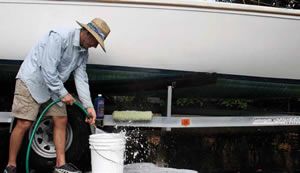Sticking to a regular boat bath regimen has multiple benefits. It not only keeps a boat looking good, but it also helps protect it from unnecessary, accelerated wear and tear. When left to bake in the sun over time, dirt, bird droppings, and environmental detritus can take their toll on fiberglass and wood finishes, and the longer you wait to swab your deck, the tougher the task will be.
Grime and dirt attract more grime and dirt, explained Bill Lindsey, marketing vice president for Star brite, a maker of marine maintenance products. And grime and dirt lead to advanced wear: Abrasion takes its toll on vinyl, fiberglass, plastic, and so on. Metal surfaces begin to show surface corrosion, which left unchecked leads to full-on rust. If you don’t maintain your boat, it will wear out much more quickly than if you clean it.
Getting a boat sparkling clean will always require a little elbow grease and muscle, but using the proper equipment and an effective soap will make the job easier and faster-allowing you more time for sailing. For this report, we tested more than a dozen boat soaps in search of those that are effective, easy to use, affordable, don’t remove wax, and wont harm the marine environment. Check out From Bubbles to Beads for details on how we tested the soaps.
The Boat Soaps We Tested
PS tested 13 products-aerosol sprays, gels, powders, and liquids-advertised as either boat soaps or wash-n-waxes. We may have missed a few, but the group offers a good cross-section of available products. The test field comprised seven liquid concentrates, three liquid sprays, one aerosol, and two gel concentrates.
The liquid- and gel-concentrate products seem to be the most logical choice for all-around cleaning and working on large areas. With these, the tougher the job, the more cleaner and less water should be used.
Sprays are useful for smaller or hard-to-access areas that need more attention. Many of the wash-n-wax products claim to clean and shine-and a few claim to clean, shine, and protect. Most can be used on fiberglass, wood, metal, and painted surfaces.
The test lineup included products from well-known marine maintenance manufacturers-Star brite, Interlux, Woody Wax, Nautical Ease, 3M, Sudbury, and Marykate-as well as some familiar in the automotive and home cleaning industries-Mothers, Ecover, Eagle One, and K2r.
Most claim to be biodegradable and to remove dirt, mold, and mildew. A few say they remove salt deposits (we expect all boat soaps to remove salt), and the majority can be used with salt water-although we don’t recommend it as the salt is abrasive to gelcoat and wood finishes.
For the most part, the products all carry safety warnings, and several recommend eye and skin protection. In our opinion, all cleaners should list active ingredients on their bottle-especially if they have safety warnings-but not all of the test soaps featured this. We like to know what we’re dealing with, so we noted those soaps that failed to list their formulas.
Our test group initially included two acid products marketed as oxidation and waterline stain removers. But because they are more specialty cleaners-what we refer to as nasty, last-resort cleaners-than general-purpose cleaners, we dropped them from this round of tests.
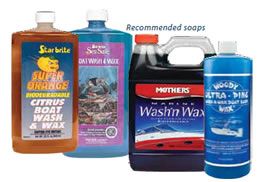
What We Found
To the eye, all of the test soaps and wash-n-waxes removed the dirt, mud, and residue from their respective fiberglass sections, so that raised the level of importance of our white-rag wipe test.
Mothers Marine Wash-n-Wax and Nautical Ease Spray Boat Cleaner fared the best, earning Excellent ratings, with no residue on their white cloths. K2r Ship Shine, Star brite Biodegradable Citrus Boat Wash & Wax, and K2r Super Spray, also did well, garnering Good ratings.
Trailing these products were Interlux All-purpose Boat Soap, Woody Wax Ultra Pine, Star brite Sea Safe Boat Wash & Wax, Ecover Ecological Boat Wash, Marykate Heavy Duty Roll Away Boat Wash, 3M Marine Boat Soap, Sudbury Boat Zoap, and Eagle One Nano Wash & Wax. All earned Fair ratings. They left the most residue on their white cloths.
In our water-beading test, two of the products completely removed the applied wax: Nautical Ease Spray Boat Cleaner and K2r Super Spray. After the second freshwater spraying, no beads formed on their panel sections. The sections cleaned with Mothers Marine Washn Wax and K2r Ship Shine showed only a few water beads. Interlux All-purpose Boat Soap, Woody Wax Ultra Pine, and Star brite Sea Safe Boat Wash & Wax left the healthiest sheet of water beads.
In the pH test, three products scored high (8.4 on the pH scale): Nautical Ease, K2r Super Spray, and Marykate. Star brite Sea Safe and Interlux scored the lowest (6.2 or less). These results confirmed our performance and water-beading tests, as the stronger, higher-pH products (more alkaline) were more effective at getting the panels clean, but they also removed more of the wax protectant. In our experience, cleaners that are more alkaline-like Marykate, 3M Spray Boat Soap, Nautical Ease, and K2r-also tend to be better de-greasers.
None of the test products indicated fiberglass-drying chlorine (or sodium chloride) as a main ingredient. However, the 3M Marine Boat Soap did test positive for it. Testers were unable to explain the result, but we did note that the 3M soap has a very small amount of caustic sodium hydroxide, an ingredient in bleach that can be toxic to marine life.
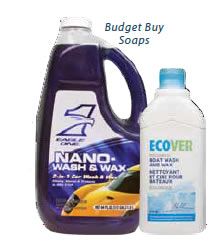
Conclusions
For a boat soap, Star Brite Citrus Boat Wash & Wax and Mothers Marine Washn Wax posted the best all-around ratings. Mothers garnered an Excellent cleaning rating, Good chemical-level scores, and got a Fair in the bead test. Star brite Citrus earned Good cleaning and bead-test ratings. Both are concentrated, eco-friendly, and safe to use on fiberglass, vinyl, metal, glass, plastic, and rubber surfaces.
We found Mothers to be less expensive at 24 cents per ounce compared to 69 cents per ounce for Star brite Citrus. Mothers also got a better cleaning score, but the Star brite scored better in the bead test, and we prefer to do our regular washings with a general-purpose boat soap that leaves wax on the boat. We reserve the harsh stuff for seriously stubborn waterline stains and pre-waxing washdowns. (For the results of our waterline-stain remover test, check out the November 2007 issue.)
Other recommendations: The Star brite SeaSafe Boat Wash & Wax was a good all-around performer and got an Excellent in the bead test; Woody Wax Ultra Pine Wash-n-Wax Boat Soap, Eagle One Nano Wash & Wax, and Ecover Ecological Boat Wash and Wax fall into the same category of solid performers. The 12-cents-per-ounce Eagle One, because it is primarily marketed as a car-wash product, is less expensive than most other products. It and the Ecover, which was the least expensive of the bunch, get our picks for Budget Buy soaps.
The spray products are really for smaller areas, so we judged them separately. Nautical Ease did a great job cleaning, but it is strong, will strip wax, and registered higher chemical levels than most others. The same can pretty much be said for the K2r Super Spray: an impressive cleaner (less expensive than Nautical Ease, too), but so strong that it takes away wax and has more harsh chemicals than others. Save these guys for mildew-ridden vinyl, galley counters, the head/shower, and smaller sections of filthy nonskid or storage lockers.
The top picks in this test are great for regular boat baths. For more on marine cleaners-including tests of specialty cleaners and gelcoat restorers, and maintenance tips-check out our downloadable, three-part e-book, Marine Cleaners: The Complete Series.
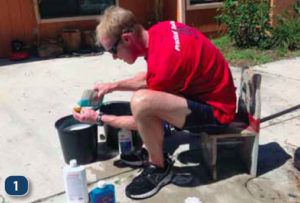
To provide an even playing field, PS testers used fiberglass panels (former hatch lids, with one side gelcoat and the other unfinished) as the test platform. The fiberglass panels had been left outside for several months and were caked with dirt, dust, and pollen. For added challenge, testers smeared both sides with some scum and mud gleaned from a nearby roadside ditch and let it dry.
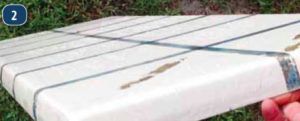
Testers then applied each test soap to a section of the panels, carefully following the instructions on each label, and noted the products’ effectiveness and ease of use. With most, the user is instructed to dilute the cleaner with water and then use a cloth, sponge, or brush to carry out the job. Only one product requires users to wait for a minute or so after applying. Products that called for dilution were mixed with fresh water in separate buckets.
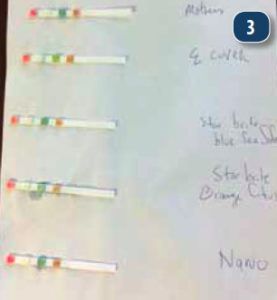
To measure the amount of grime left on the panel sections after cleaning, testers wiped them with a clean white rag and compared the results. The soaps also endured a water-beading test to determine whether they stripped wax from the panels. After the panels were cleaned and waxed, testers sprayed water on them and noted how well water beaded. They then applied the test soaps to their respective sections, sprayed the panels again, and noted which sections maintained their water-beading ability.
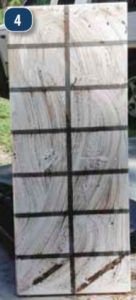
Finally, PS measured each product’s pH balance and chemical levels, using color-changing indicator strips. The pH value is a measurement of a substance’s acidity and alkalinity. Solutions with a pH less than 7 are said to be acidic, and solutions with a pH greater than 7 are basic or alkaline. The stronger and harsher the soap, the higher the pH level. For example: Lemon juice has a pH of 2, baking soda is an 8, and distilled water is a neutral 7. The results of all of these tests, along with the price of the products, were considered in the overall ratings.
Boat Soaps & Wash-N-Waxes
| TYPE | PRODUCT | PRICE / PRICE PER OUNCE | SIZE | CLEANER TYPE | CLEANING | WATER BEADING | pH TEST |
|---|---|---|---|---|---|---|---|
| WASH-N-WAXES | MOTHERS MARINE | $7.80 / 24¢ | 32 oz. | Liquid | Excellent | Fair | Neutral-range |
| ECOVER ECOLOGICAL | $1.49 / 9¢ | 16.9 oz. | Liquid | Fair | Good | Neutral-range | |
| STAR BRITE BIODEGRADABLE CITRUS | $22.05 / 69¢ | 32 oz. | Gel | Good | Good | Neutral-range | |
| STAR BRITE SEASAFE | $22.05 / 69¢ | 32 oz. | Liquid | Fair | Excellent | Acidic | |
| EAGLE ONE NANO | $7.94 / 12¢ | 64 oz. | Liquid | Fair | Good | Neutral-range | |
| WOODY WAX ULTRA PINE | $20.80 / 61¢ | 34 oz. | Gel Conc. | Fair | Excellent | Neutral-range | |
| K2R SHIP SHINE | $12.99 / 76¢ | 17 oz. | Aerosol | Good | Fair | Neutral-range | |
| MARYKATE HEAVY DUTY ROLL AWAY | $12.85 / 40¢ | 32 oz. | Spray | Fair | Good | Alkaline | |
| BOAT SOAPS | INTERLUX ALL-PURPOSE | $10.95 / 65¢ | 16.9 oz. | Gel Conc. | Fair | Excellent | Acidic |
| NAUTICAL EASE | $9.95 / 31¢ | 32 oz. | Spray | Excellent | Poor | Alkaline | |
| 3M MARINE BOAT SOAP | $17.28 / $1.08 | 16 oz. | Gel Conc. | Fair | Excellent | Neutral-range | |
| SUDBURY BOAT ZOAP | $12.49 / 39¢ | 32 oz. | Lquid Conc. | Fair | Good | Neutral-range | |
| Z2R SUPER SPRAY | $9.99 / 31¢ | 32 oz. | Spray | Good | Poor | Alkaline |
* After a day on the water, rinse the boat thoroughly with fresh water, and then wash all the surfaces with a quality boat wash.
* Work from the top of the boat down. Lather up, scrub, and rinse. Knock off the job in sections. If you lather up the entire boat, portions could dry before you get to them.
* If you have an outboard, include it in your boat cleaning routine. Salt accumulates in the nooks and crannies of the motor mount, just under the lower cowling, and the lower unit.
* To avoid water spots, chami the boat dry right away. Find some soft, highly absorbent drying cloths to soak up the water without scratching or removing wax. Chamois cloths or drying mops made of chamois material are good choices.
* According to Star brite’s Bill Lindsey, you should apply a protective polymer polish (PS, September 2012) to all fiberglass and polished metal surfaces at least once per year. “In addition to keeping the treated surfaces looking good, it will help repel grime and oxidation,” he said. Also, apply a vinyl polish to those fabrics to protect them from UV and to repel dirt.
* Keep a bottle of boat wash and a sponge on the boat to take care of spills seconds after they occur. “Dunking a sponge over the side to swab down a spilled soda when it happens saves you from having a sticky, stained deck when you get home and prevents your guests from tracking that mess all over the boat, compounding the cleanup chore,” Lindsey said.
* Use products that are formulated for use on fiberglass, rubber, and stainless. Stay away from harsh and toxic chemicals like muriatic acid (pool cleaner), toilet bowl cleaner, and bleach, Lindsey advised. “Bleach can dry out fiberglass, destroy the stitches holding your vinyl upholstery together, kill sea life, and it can burn your skin or eyes if splashed. Dishwashing detergent strips wax.”
What about muriatic acid? It’s so strong that it increases the size of the pores in a gelcoat. The dirt and grime may be gone after using muriatic acid, but you’ve left behind larger crannies for dirt to settle into. “And of course you are damaging the gelcoat at the same time,” says Lindsey. In the case of stubborn stains that resist cleaning by less aggressive cleaning products, products with oxalic or other milder acids can be used with caution. Check out the November 2007 report on waterline stain removers to find out our top picks.





























